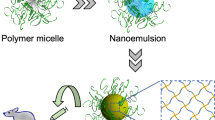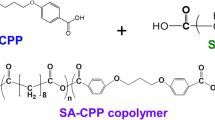Abstract
Emulsions, usually oil-in-water emulsions, have been widely applied to the preparation of hydrophobic drug carriers. However, the synthesis of safe, biocompatible and high-performance carriers for water-soluble drugs remains a challenge. So polyacrylamide (PAM) microspheres stabilized by carbon dots (CDs) were fabricated via a water-in-oil Pickering emulsion without the use of any surfactant. The PAM/CD microspheres were spherical with an even distribution of the CDs on their surfaces. The size of the microspheres can be controlled by changing the amount of CDs, which also influenced the drug loading properties. The hydrophilic chemotherapy drug, 5-fluorouracil (5-FU), was successfully loaded into the PAM/CD microspheres through incubation. The encapsulation efficiencies ranged from 68 to 82% with a maximum drug loading of 48%. The 5-FU release profiles depended on the concentration of the drug incubation solution, the concentration of the CD solution and the pH of the drug release environment. The release of 5-FU was relatively steady for the first 12 h and followed non-Fickian diffusion kinetics. This synthetic approach could be extrapolated to loading of other water-soluble drugs into hydrophilic polymers.












Similar content being viewed by others
References
Schmaljohann D (2006) Thermo- and pH-responsive polymers in drug delivery. Adv Drug Deliv Rev 58:1655–1670
Biswal AK, Usmani M, Ahammad SZ, Saha S (2018) Unveiling the slow release behavior of hollow particles with prolonged antibacterial activity. J Mater Sci 53:5942–5957. https://doi.org/10.1007/s10853-018-1991-3
Gamboa JM, Leong KW (2013) In vitro and in vivo models for the study of oral delivery of nanoparticles. Adv Drug Deliv Rev 65:800–810
Parthipan AK, Gupta N, Pandey K, Sharma B, Jacob J, Saha S (2018) One-step fabrication of bicompartmental microparticles as a dual drug delivery system for Parkinson’s disease management. J Mater Sci. https://doi.org/10.1007/s10853-018-2819-x
Kokil GR, Veedu RN, Le BT, Ramm GA, Parekh HS (2018) Self-assembling asymmetric peptide-dendrimer micelles—a platform for effective and versatile in vitro nucleic acid delivery. Sci Rep UK 8(4832):1–16
Yang KK, Kong M, Wei YN et al (2013) Folate-modified-chitosan-coated liposomes for tumor-targeted drug delivery. J Mater Sci 48:1717–1728. https://doi.org/10.1007/s10853-012-6930-0
Dai J, Lin S, Cheng D, Zou S, Shuai X (2011) Interlayer-crosslinked micelle with partially hydrated core showing reduction and pH dual sensitivity for pinpointed intracellular drug release. Angew Chem Int Edit 50:9404–9408
Weber S, Zimmer A, Pardeike J (2014) Solid lipid nanoparticles (SLN) and nanostructured lipid carriers (NLC) for pulmonary application: a review of the state of the art. Eur J Pharm Biopharm 86(1):7–22
Cheng R, Meng F, Deng C, Klok H, Zhong Z (2013) Dual and multi-stimuli responsive polymeric nanoparticles for programmed site-specific drug delivery. Biomaterials 34:3647–3657
Croissant J, Zink JI (2012) Nanovalve-controlled cargo release activated by plasmonic heating. J Am Chem Soc 134:7628–7631
Senol S, Akyol E (2018) Synthesis and characterization of hydrogels based on poly(2-hydroxyethyl methacrylate) for drug delivery under UV irradiation. J Mater Sci. https://doi.org/10.1007/s10853-018-2713-6
Abdul Hamid ZA, Tham CY, Ahmad Z (2018) Preparation and optimization of surface-engineered poly(lactic acid) microspheres as a drug delivery device. J Mater Sci 53:4745–4758. https://doi.org/10.1002/vnl.21369
Dozie-Nwachukwu SO, Danyuo Y, Obayemi JD, Odusanya OS, Malatesta K, Soboyejo WO (2017) Extraction and encapsulation of prodigiosin in chitosan microspheres for targeted drug delivery. Mat Sci Eng C Mater 71:268–278
Porter C, Trevaskis NL, Charman WN (2007) Lipids and lipid-based formulations: optimizing the oral delivery of lipophilic drugs. Nat Rev Drug Discov 6:231–248
Lupi FR, Gabriele D, Seta L, Baldino N, de Cindio B, Marino R (2015) Rheological investigation of pectin-based emulsion gels for pharmaceutical and cosmetic uses. Rheol Acta 54:41–52
Rahate AR, Nagarkar JM (2007) Emulsification of vegetable oils using a blend of nonionic surfactants for cosmetic applications. J Dispers Sci Technol 28:1077–1080
Chevalier Y, Bolzinger M (2013) Emulsions stabilized with solid nanoparticles: Pickering emulsions. Colloids Surf A 439:23–34
Zhang X, Hu X, Guan P, Zhang N, Li J, Du C (2011) Immunostimulating peptide interfacial imprinted magnetic microspheres synthesized via Pickering emulsion polymerization. J Mater Sci 52:4713–4726. https://doi.org/10.1021/ma200837n
Dickinson E (2010) Food emulsions and foams: stabilization by particles. Curr Opin Colloid Interface Sci 15:40–49
Pang B, Liu H, Liu PW, Peng XW, Zhang K (2018) Water-in-oil Pickering emulsions stabilized by stearoylated microcrystalline cellulose. J Colloid Interface Sci 513:629–637
Zou SW, Wang CY, Gao QX, Tong Z (2013) Surfactant-free multiple Pickering emulsions stabilized by combining hydrophobic and hydrophilic nanoparticles. J Dispers Sci Technol 34:173–181
Yang Y, Wei Z, Wang C, Tong Z (2013) Versatile fabrication of nanocomposite microcapsules with controlled shell thickness and low permeability. ACS Appl Mater Interfaces 5:2495–2502
Amalvy JI, Unali GF, Li Y, Granger-Bevan S, Armes SP, Binks BP et al (2004) Synthesis of sterically stabilized polystyrene latex particles using cationic block copolymers and macromonomers and their application as stimulus-responsive particulate emulsifiers for oil-in-water emulsions. Langmuir 20:4345–4354
Matos M, Laca A, Rea F, Iglesias O, Rayner M, Gutierrez G (2018) O/W emulsions stabilized by OSA-modified starch granules versus non-ionic surfactant: stability, rheological behaviour and resveratrol encapsulation. J Food Eng 222:207–217
Eskandar NG, Simovic S, Prestidge CA (2007) Synergistic effect of silica nanoparticles and charged surfactants in the formation and stability of submicron oil-in-water emulsions. Phys Chem Chem Phys 9:6426–6434
Voorn DJ, Ming W, van Herk AM (2006) Polymer–clay nanocomposite latex particles by inverse pickering emulsion polymerization stabilized with hydrophobic montmorillonite platelets. Macromolecules 39:2137–2143
Wang H, Hobbie EK (2003) Amphiphobic carbon nanotubes as macroemulsion surfactants. Langmuir 19:3091–3093
Hobbie EK, Bauer BJ, Stephens J et al (2005) Colloidal particles coated and stabilized by DNA-wrapped carbon nanotubes. Langmuir 23:10284–10287
Hobbie EK, Fagan JA, Obrzut J, Hudson SD (2009) Microscale polymer-nanotube composites. ACS Appl Mater Interfaces ACS Appl Mater Interfaces 1:1561–1566
Yang W, Zhang L, Guo Y et al (2016) Novel segregated-structure phase change materials composed of paraffin@graphene microencapsules with high latent heat and thermal conductivity. J Mater Sci 53:2566–2575. https://doi.org/10.1371/journal.pone.0144179
He Y, Wu F, Sun X, Li R, Guo Y, Li C et al (2013) Factors that affect Pickering emulsions stabilized by graphene oxide. ACS Appl Mater Interfaces 5:4843–4855
Wang Y, Hu A (2014) Carbon quantum dots: synthesis, properties and applications. J Mater Chem C 2(34):6921–6939
Nezhad-Mokhtari P, Arsalani N, Ghorbani M, Hamishehkar H (2018) Development of biocompatible fluorescent gelatin nanocarriers for cell imaging and anticancer drug targeting. J Mater Sci 53:10679–10691. https://doi.org/10.1021/acsnano.5b05575
Wang C, Wang C, Xu P, Li A, Chen Y, Zhuo K (2016) Synthesis of cellulose-derived carbon dots using acidic ionic liquid as a catalyst and its application for detection of Hg2+. J Mater Sci 51:861–867. https://doi.org/10.1371/journal.pone.0144179
Li Q, Cui C, Meng H, Yu J (2014) Visible-light photocatalytic hydrogen production activity of ZnIn2S4 microspheres using carbon quantum dots and platinum as dual cocatalysts. Chem Asian J 9:1766–1770
Ding Y, Zhang F, Xu J, Miao Y, Yang Y, Liu X et al (2017) Synthesis of short-chain passivated carbon quantum dots as the light emitting layer towards electroluminescence. RSC Adv 7:28754–28762
Hou J, Yan J, Zhao Q, Li Y, Ding H, Ding L (2013) A novel one-pot route for large-scale preparation of highly photoluminescent carbon quantum dots powders. Nanoscale 5:9558–9561
Li R, Liu L, Zhu H, Li Z (2018) Synthesis of gold-palladium nanowaxberries/dodecylamine-functionalized graphene quantum dots-graphene micro-aerogel for voltammetric determination of peanut allergen Arah1. Anal Chim Acta 1008:38–47
Lim SY, Shen W, Gao Z (2015) Carbon quantum dots and their applications. Chem Soc Rev 44:362–381
Ritger PL, Peppas NA (1987) A simple equation for description of solute release I. Fickian and non-Fickian release from non-swellable devices in the form of slabs, spheres, cylinders or discs. J Control Release 5:23–36
Guo X, Ji W, Wang C, Chen S (2016) Herbages-derived fluorescent carbon dots and CdTe/carbon ensembles for patterning. J Mater Sci 51(17):8108–8115. https://doi.org/10.1186/s11671-016-1262-7
Golemanov K, Tcholakova S, Kralchevsky PA, Ananthapadmanabhan KP, Lips A (2006) Latex-particle-stabilized emulsions of anti-Bancroft type. Langmuir 22:4968–4977
Yang J, Gao J, Wang X, Mei S, Zhao R, Hao C et al (2017) Polyacrylamide hydrogel as a template in situ synthesis of CdS nanoparticles with high photocatalytic activity and photostability. J Nanopart Res 19(350):1–13
Bach LG, Islam MR, Hong S, Lim KT (2013) A simple preparation of a STab. CdS-polyacrylamide nanocomposite: structure, thermal and optical properties. J Nanosci Nanotechnol 13:7707–7711
Mu TC, Du JM, Li ZH, Liu ZM, Han BX, Wang JQ et al (2004) Preparation of polyacrylamide/CdS nanocomposites by a combination of reverse microemulsion and CO2 antisolvent techniques. Colloid Polym Sci 282:1179–1183
Orozco-Guareño E, Santiago-Gutiérrez F, Morán-Quiroz JL, Hernandez-Olmos SL, Soto V, Gomez-Salazar S et al (2010) Removal of Cu(II) ions from aqueous streams using poly(acrylic acid-co-acrylamide) hydrogels. J Colloid Interface Sci 349:583–593
Jin J, Zhu S, Song Y, Zhao H, Zhang Z, Guo Y et al (2016) Precisely controllable core–shell Ag@carbon dots nanoparticles: application to in situ super-sensitive monitoring of catalytic reactions. ACS Appl Mater Interfaces 8:27956–27965
Lu S, Xiao G, Sui L, Feng T, Yong X, Zhu S et al (2017) Piezochromic carbon dots with two-photon fluorescence. Angew Chem Int Ed 56:6187–6191
Beamson G, Briggs D (1992) High resolution XPS of organic polymers: the scienta ESCA300 database. Wiley, New York
Solomon Jones S, Sahatiya P, Badhulika S (2017) One step, high yield synthesis of amphiphilic carbon quantum dots derived from chia seeds: a solvatochromic study. N J Chem 41:13130–13139
Mewada A, Pandey S, Shinde S, Mishra N, Oza G, Thakur M et al (2013) Green synthesis of biocompatible carbon dots using aqueous extract of Trapa bispinosa peel. Mater Sci Eng C 33:2914–2917
Wang D, Liu J, Chen J, Dai L (2016) Surface functionalization of carbon dots with polyhedral oligomeric silsesquioxane (POSS) for multifunctional applications. Adv Mater Interfaces 3(1500439):1–6
Maaoui H, Teodoresu F, Wang Q, Pan G, Addad A, Chtourou R et al (2016) Non-enzymatic glucose sensing using carbon quantum dots decorated with copper oxide nanoparticles. Sens Basel 16(1720):1–10
Chae A, Choi Y, Jo S, Nur’Aeni N, Paoprasert P, Park SY et al (2017) Microwave-assisted synthesis of fluorescent carbon quantum dots from an A2/B3 monomer set. RSC Adv 7:12663–12669
Thambiraj S, Ravi SD (2016) Green synthesis of highly fluorescent carbon quantum dots from sugarcane bagasse pulp. Appl Surf Sci 390:435–443
Cheng F, An X, Zheng C, Cao S (2015) Green synthesis of fluorescent hydrophobic carbon quantum dots and their use for 2,4,6-trinitrophenol detection. RSC Adv 5:93360–93363
Zhao X, Li K, Zhao X, Pang D, Chen D (2008) Study on colon-specific 5-Fu pH-enzyme Di-dependent chitosan microspheres. Chem Pharm Bull 56:963–968
Muvaffak A, Gürhan I, Hasirci N (2008) Cytotoxicity of 5-fluorouracil entrapped in gelatin microspheres. J Microencapsul 21:293–306
Abulateefeh SR, Alkilany AM (2016) Synthesis and characterization of PLGA shell microcapsules containing aqueous cores prepared by internal phase separation. AAPS PharmSciTech 17:891–897
Bravo SA, Lamas MC, Salamon CJ (2002) In-vitro studies of diclofenac sodium controlled-release from biopolymeric hydrophilic matrices. J Pharm Pharm Sci 5(3):213–219
Tomić SL, Mićić MM, Filipović JM et al (2007) Swelling and drug release behavior of poly (2-hydroxyethyl methacrylate/itaconic acid) copolymeric hydrogels obtained by gamma irradiation. Radiat Phys Chem 76(5):801–810
Martínez-Gómez F, Guerrero J, Matsuhiro B, Pavez J (2017) In vitro release of metformin hydrochloride from sodium alginate/polyvinyl alcohol hydrogels. Carbohydr Polym 155:182–191
Mandal BB, Kapoor S, Kundu SC (2009) Silk fibroin/polyacrylamide semi-interpenetrating network hydrogels for controlled drug release. Biomaterials 30(14):2826–2836
Su H, Jia Q, Shan S (2016) Synthesis and characterization of Schiff base contained dextran microgels in water-in-oil inverse microemulsion. Carbohydr Polym 152:156–162
Acknowledgements
This work was supported by the National Science Foundation of China (51573126).
Author information
Authors and Affiliations
Corresponding author
Ethics declarations
Conflict of interest
The authors declare that they have no conflict of interest.
Electronic supplementary material
Below is the link to the electronic supplementary material.
Rights and permissions
About this article
Cite this article
Wang, L., Gao, J., An, Z. et al. Polymer microsphere for water-soluble drug delivery via carbon dot-stabilizing W/O emulsion. J Mater Sci 54, 5160–5175 (2019). https://doi.org/10.1007/s10853-018-03197-7
Received:
Accepted:
Published:
Issue Date:
DOI: https://doi.org/10.1007/s10853-018-03197-7




